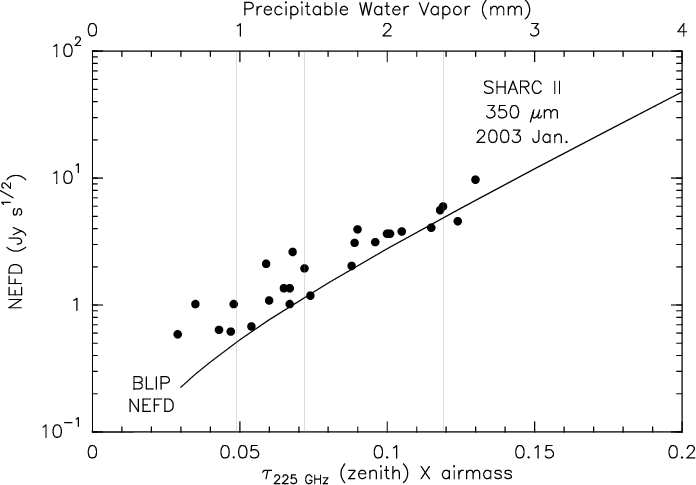Table of Contents
SHARC II
The Submillimeter High Angular Resolution Camera II (SHARC II) is a second generation 350/450 μm camera with a 12×32 bolometer array. For polarimetry, the SHARP foreoptics are installed.
-
- SHARC II: a CSO facility camera with 384 pixels
Dowell, C. D., Allen, C. A., Babu, R. S., Freund, M. M., Gardner, M., Groseth, J., Jhabvala, M. A., Kovacs, A., Lis, D. C., Moseley, S. H., Jr., Phillips, T. G., Silverberg, R. F., Voellmer, G. M., Yoshida, H.
2003 Proc. SPIE 4855, 73 ADS
- Operating the instrument
- Cryogenics, including 3He fridge cycle
-
- Atmospheric transparency (τ fits)
- Pointing model 2012 October update
- News regarding 2006 June 23–July 7 data
- Workshop (2004 November)
- Pointing memo (2004 September)
- Miscellaneous
- Electronics guide
- Installation guide
Overview
Introduction
SHARC II operates at the Caltech Submillimeter Observeratory (CSO). It is the world's first facilty “CCD style” bolometer array, and employs “pop up” detector technology to form an 12×32 pixel array. Unlike some other instruments, SHARC II does not (typically) use chopping to remove the sky background. Instead the telescope is scanned continuously and the bolometers are sampled every 33 msec. Then we can use the “total power” data to estimate the sky contribution and remove it in software.
Approximately 85% of the 384 bolometers work well. Each pixel has an extent of 4.85 arcsec, resulting in a 2.59 arcmin x 0.97 arcmin field of view. (Pixel scale updated Feb. 2003.)
The beam size with good focus and pointing is 8–9 arcsec (full width half maximum) at 350 µm wavelength.
Filters
SHARC II has three filters in a manually operated wheel: 350 µm, 450 µm, and 850 µm. We observe nearly background limited performance at 350 µm and expect the same at 450 µm. At 850 µm, we expect an NEFD of about 1–2 Jy s1/2 — 10–20x worse than SCUBA. We anticipate very little observing at 850 µm.
Sensitivity and Time Calculation Basics
Deep SHARC II integrations require good weather, τ225 GHz ≤ 0.05 (precipitable water vapor ≤ 1 mm). Overall, this occurs about 20% of the time. happens 10% of the time in “summer” (May - November) and 27% of the time in “winter” (December - April). When τ225 GHz = 0.05, the 350 µm NEFD at 1.3 airmass (ZA = 40°) is 1 Jy s1/2. At 450 µm, we expect a similar NEFD. Here are some example sensitivity estimates for one field of view, assuming the stated weather and airmass and assuming 50% loss of time due to overheads (recording data, pointing, calibration, etc):
| time | 1-sigma rms |
|---|---|
| 1 hr | 24 mJy |
| 3 hr | 14 mJy |
| 10 hr | 7 mJy |
In other conditions, estimate NEFD = 1 Jy s1/2 x exp(25 τ225 A - 1.6), where the airmass A = sec(ZA).
NEFD, 2003 January

Preliminary 350 µm NEFD measurements (points) from commissioning observations in 2003 January compared with the theoretical expectation (line). We confirm the performance of 1 Jy s1/2 when τ225 = 0.05.
We do not yet have NEFD measurements at 450 µm.
Field Rotation
SHARC II sits on an instrument rotator, which in principle can be used to correct for parallactic angle rotation. The user should verify that the actual rotator position (APA on antenna monitor) is close to the requested rotator position (RPA), and also watch out for rotation-dependent pointing offsets. Cable restrictions are fairly minor if things are set up well, but should be monitored for large rotations. It should be noted that we very rarely use the rotator. Contact the staff if you feel the use of it is required for your program.
Availability of Other Instruments with SHARC II Installed
SHARC II is mounted on the left Nasmyth platform. The heterodyne receivers in the sidecab (i. e., at the other Nasmyth focus) or instruments at the Cassegrain focus, such as Music, can be used by repositioning the tertiary mirror appropriately.
Observing Modes
The primary observing mode of SHARC II is scanning. We have developed two routines to record data while performing controlled curved, Lissajous, and linear scans. These are called SWEEP and BOX_SCAN, respectively, in the UIP. SWEEP is most appropriate for maps comparable to the size of the detector array and BOX_SCAN is better for larger maps. The stability timescale of a SHARC II bolometer is approximately 10 seconds; to achieve full sensitivity, one should scan from off source to on source to off source within this time.
There is also limited support for chopped observations. It has been used in cases where faint point sources were the target, and sky variability a concern. If you are interested in chopped mode observations, contact the SHARC II experts.
Analysis Software
The primary data reduction package, CRUSH, is a Java tool that runs on most platforms (Linux, OS X, Windows, and Solaris). A small number of alternate utilities are also available. Please see the SHARC II Data Analysis pages.
Raw SHARC II data will occupy about 3 GB on a good night. Generally observers only need to keep the reduced data.